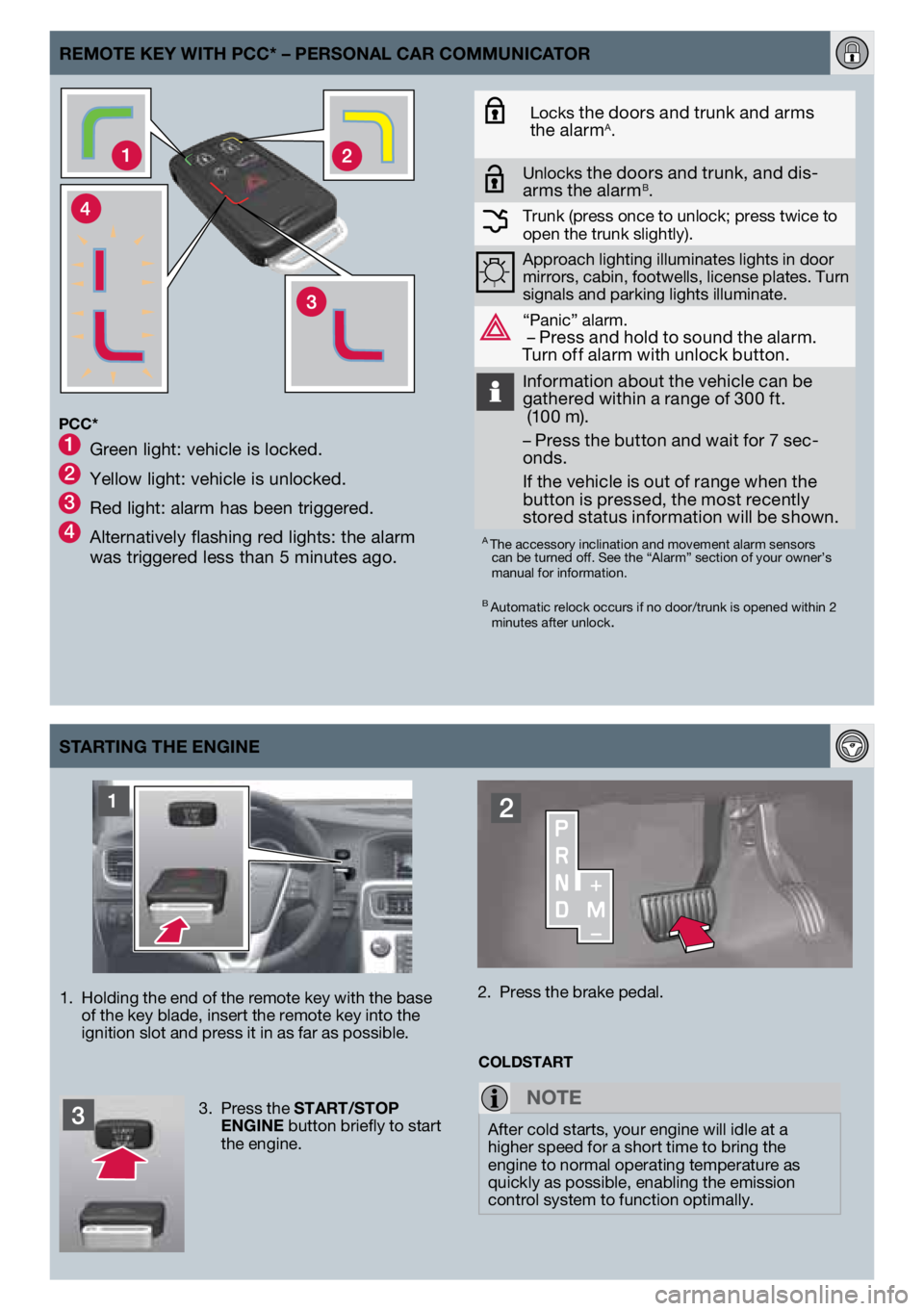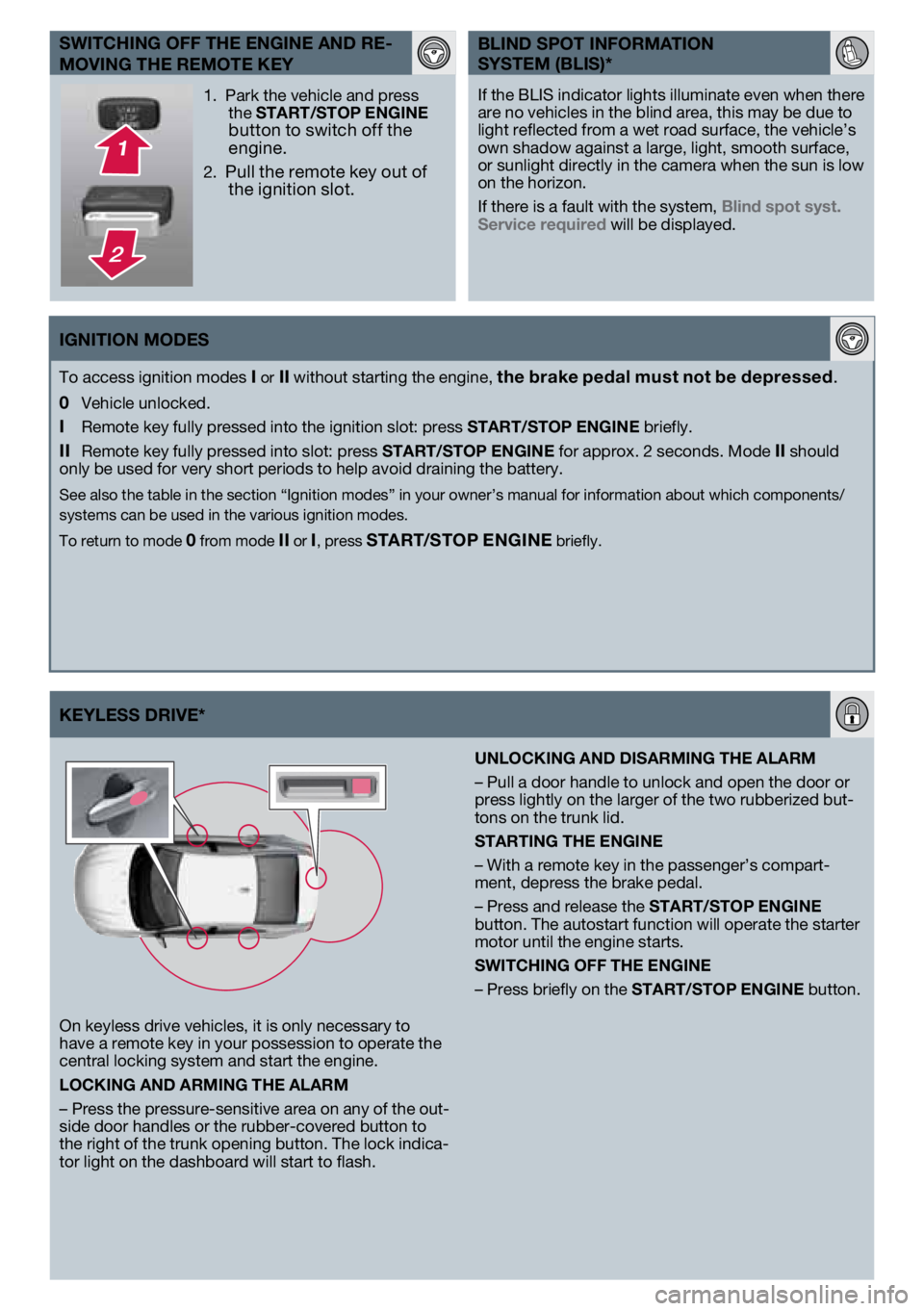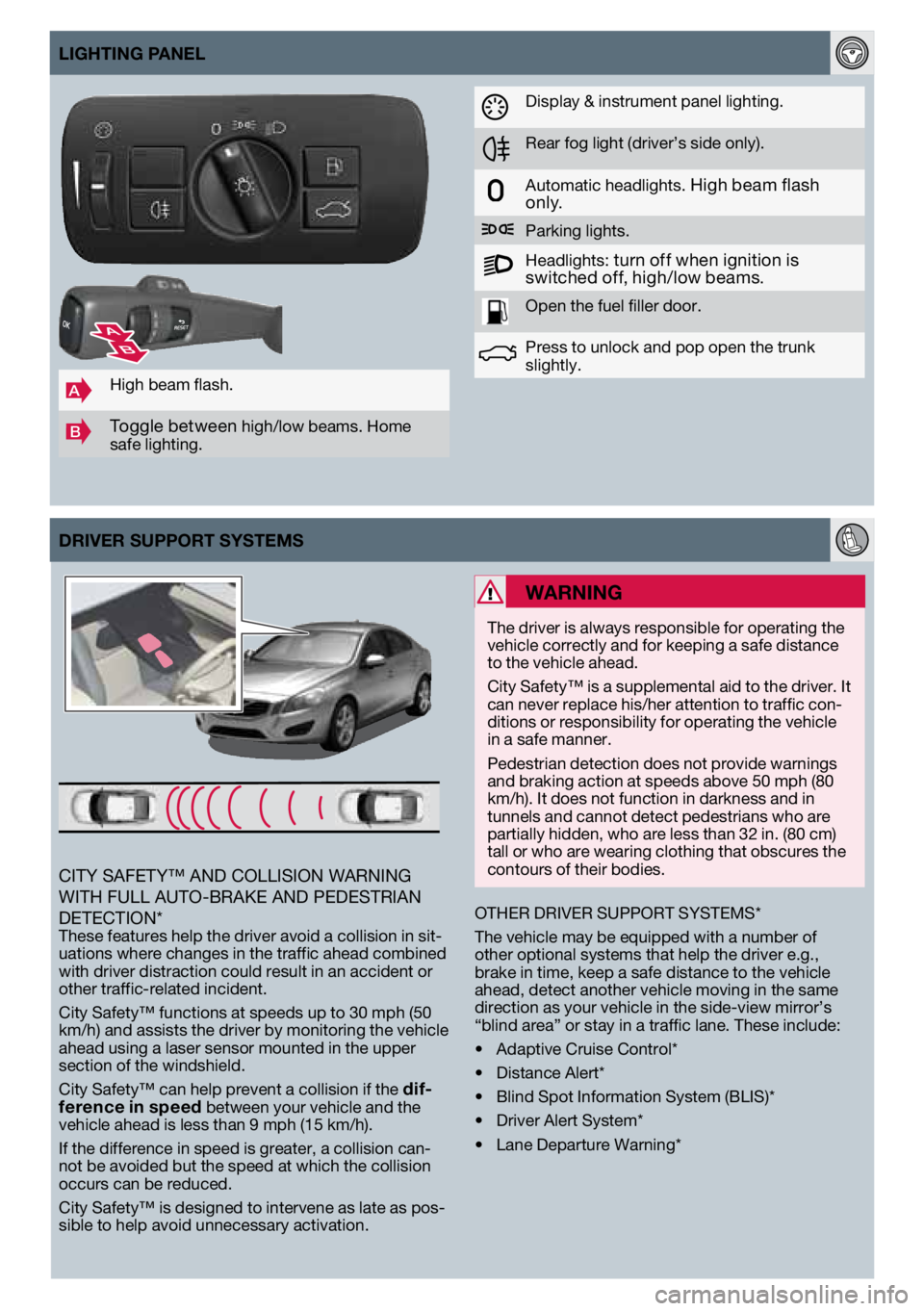lights VOLVO S60 2013 Quick Guide
[x] Cancel search | Manufacturer: VOLVO, Model Year: 2013, Model line: S60, Model: VOLVO S60 2013Pages: 8, PDF Size: 2.72 MB
Page 2 of 8

PCC*1 Green light: vehicle is locked.
2 Yellow light: vehicle is unlocked.
3 Red light: alarm has been triggered.
4 Alternatively flashing red lights: the alarm
was triggered less than 5 minutes ago.
3. Press the START/STOP
ENGINE button briefly to start
the engine.
1.
Holding the end of the remote key with the base
of the key blade, insert the remote key into the
ignition slot and press it in as far as possible. 2.
Press the brake pedal.
Locks the doors and trunk and arms
the alarmA.
Unlocks the doors and trunk, and dis -
arms the alarmB.
Trunk (press once to unlock; press twice to
open the trunk slightly).
Approach lighting illuminates lights in door
mirrors, cabin, footwells, license plates. Turn
signals and parking lights illuminate.
“Panic” alarm. – Press and hold to sound the alarm.
Turn off alarm with unlock button.
Information about the vehicle can be
gathered within a range of 300 ft.
(10 0 m).
– Press the button and wait for 7 sec -
onds.
If the vehicle is out of range when the
button is pressed, the most recently
stored status information will be shown.
A The accessory inclination and movement alarm sensors can be turned off. See the “Alarm” section of your owner’s
manual for information.
B Automatic relock occurs if no door/trunk is opened within 2
minutes after unlock.
REMOTE KEY WITH PCC* – PERSONAl CAR COMMuNICATOR
STARTING THE ENGINE
COlDSTART
NOTE
After cold starts, your engine will idle at a
higher speed for a short time to bring the
engine to normal operating temperature as
quickly as possible, enabling the emission
control system to function optimally.
Page 3 of 8

To access ignition modes I or II without starting the engine, the brake pedal must not be depressed.
0
Vehicle unlocked.
I Remote key fully pressed into the ignition slot: press START/STOP ENGINE briefly.
II Remote key fully pressed into slot: press START/STOP ENGINE for approx. 2 seconds. Mode II should
only be used for very short periods to help avoid draining the battery.
See also the table in the section “Ignition modes” in your owner’\
s manual for information about which components/
systems can be used in the various ignition modes.
To return to mode
0 from mode II or I, press START/STOP ENGINE briefly.
KEYlESS DRIvE*
On keyless drive vehicles, it is only necessary to
have a remote key in your possession to operate the
central locking system and start the engine.
lOCKING AND ARMING THE AlARM
– Press the pressure-sensitive area on any of the out-
side door handles or the rubber-covered button to
the right of the trunk opening button. The lock indica-
tor light on the dashboard will start to flash. uNlOCKING AND DISARMING THE AlARM
– Pull a door handle to unlock and open the door or
press lightly on the larger of the two rubberized but-
tons on the trunk lid.
STARTING THE ENGINE
– With a remote key in the passenger’s compart-
ment, depress the brake pedal.
– Press and release the START/STOP ENGINE
button. The autostart function will operate the starter
motor until the engine starts.
SWITCHING OFF THE ENGINE
– Press briefly on the START/STOP ENGINE button.
1.
Park the vehicle and press
the START/STOP ENGINE
button to switch off the
engine.
2. Pull the remote key out of the ignition slot.
If the BLIS indicator lights illuminate even when there
are no vehicles in the blind area, this may be due to
light reflected from a wet road surface, the vehicle’s
own shadow against a large, light, smooth surface,
or sunlight directly in the camera when the sun is low
on the horizon.
If there is a fault with the system, Blind spot syst.
Service required will be displayed.
SWITCHING OFF THE ENGINE AND RE-
MOvING THE REMOTE KEY BlIND SPOT INFORMATION
SYSTEM (BlIS)*
IGNITION MODES
Page 7 of 8

DRIvER SuPPORT SYSTEMS
AHigh beam flash.
BToggle between high/low beams. Home
safe lighting.
lIGHTING PANEl
Display & instrument panel lighting.
Rear fog light (driver’s side only).
Automatic headlights. High beam flash
only.
Parking lights.
Headlights: turn off when ignition is
switched off, high/low beams.
Open the fuel filler door.
Press to unlock and pop open the trunk
slightly.
CITY SAFETY™ AND COLLISION WARNING
WITH FULL AUTO-BRAKE AND PEDESTRIAN
DETECTION*
These features help the driver avoid a collision in sit-
uations where changes in the traffic ahead combined
with driver distraction could result in an accident or
other traffic-related incident.
City Safety™ functions at speeds up to 30 mph (50
km/h) and assists the driver by monitoring the vehicle
ahead using a laser sensor mounted in the upper
section of the windshield.
City Safety™ can help prevent a collision if the
dif -
ference in speed between your vehicle and the
vehicle ahead is less than 9 mph (15 km/h).
If the difference in speed is greater, a collision can-
not be avoided but the speed at which the collision
occurs can be reduced.
City Safety™ is designed to intervene as late as pos-
sible to help avoid unnecessary activation.
WARNING
The driver is always responsible for operating the
vehicle correctly and for keeping a safe distance
to the vehicle ahead.
City Safety™ is a supplemental aid to the driver. It
can never replace his/her attention to traffic con-
ditions or responsibility for operating the vehicle
in a safe manner.
Pedestrian detection does not provide warnings
and braking action at speeds above 50 mph (80
km/h). It does not function in darkness and in
tunnels and cannot detect pedestrians who are
partially hidden, who are less than 32 in. (80 cm)
tall or who are wearing clothing that obscures the
contours of their bodies.
OTHER DRIVER SUPPORT SYSTEMS*
The vehicle may be equipped with a number of
other optional systems that help the driver e.g.,
brake in time, keep a safe distance to the vehicle
ahead, detect another vehicle moving in the same
direction as your vehicle in the side-view mirror’s
“blind area” or stay in a traffic lane. These include:
• Adaptive Cruise Control*
• Distance Alert*
• Blind Spot Information System (BLIS)*
• Driver Alert System*
• Lane Departure Warning*